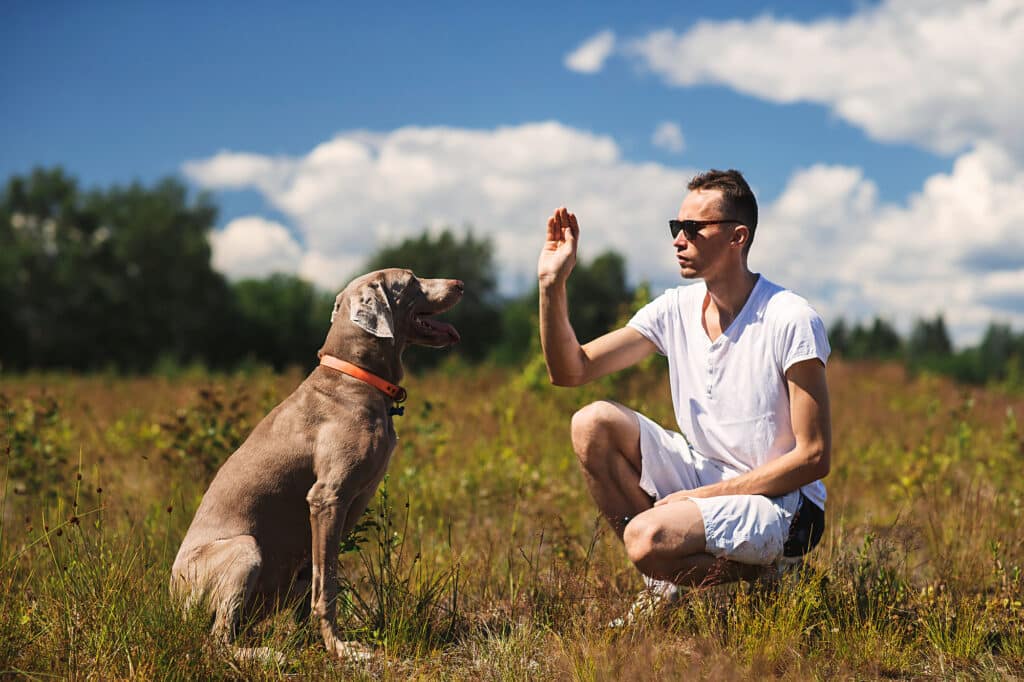
No matter where your training journey lies, hand signals can make the task much simpler! From starting from the very start of training process to working through all levels, they provide invaluable assistance when training a pup!
Hand signals can be an extremely effective tool in improving communication with your puppy or dog! Signaling makes it simple to convey verbal cues from around distractions or from faraway.
Today we’re discussing dog training, dog hand signals. why they are important, some popular ones that you could teach your pup, and how you can successfully help him learn them.
Why Should You Train Your Dog To Respond To Hand Signals?
Hand signals will allow you to effectively interact with your deaf dogs or any senior or younger dog that develops hearing loss over time. Learning hand signals gives you a reliable method for communicating with your dog.
As cars, people, and other distractions could prevent your dog from hearing you or voice commands clearly. It becomes even more crucial that communication with cues with your dog as the environment may present more hazards or risks to both parties.
Dogs tend to be adept at picking up on body language more than specific words you say. It’s easier for them to associate a gesture with behavior than distinguish between various sounds that compose one word.
Why Use Hand Signals for Dogs?
Visual communication is very effective because dogs understand and interpret their body language and can readily understand their surroundings and signals. Dogs can respond to visual stimuli more easily. One study aimed at dogs who were given visual and auditory cues for the first time. Hand-only visual cues only reached 92% accuracy while voice cues remained 80% reliability compared with hand. Hand signal is incredibly useful in noisy environments. A terrier can concentrate on his handling position easily among such distractions as in the absence.
What are The Basic Hand Signals for Dog Training?
We will start with an anatomy class. The dog’s sensory system is the same as that of a human being. It has a nose that senses our smell and eyes for our vision. So it only seems appropriate that our training approaches are targeted at most of the senses (sight or hearing) in this case. There are also specific scenarios where hand signals are even more beneficial than verbal commands or signals. How to train a deaf dog Plus, learning a new skill continuously strengthens your dog’s bonds.
Basic hand signals can significantly enhance communication with your dog. They are an excellent way of instructing your pet without using your voice and can be essential to obedience training. The most common signals include the palm facing out for “stay,” pointing forward for “go,” a flat hand for “down,” and a closed fist for “come.” For “sit,” use an upward-facing palm. Eye contact is crucial to reinforce the signal, ensuring that your dog understands what you are trying to communicate. Consistency and repetition play a vital role in training dogs and helping them develop the required habits. It’s important to start with one command and gradually progress to more signals as your dog adapts to each one. As with all dog- training methods, maintain patience and never resort to physical force if they don’t respond favorably.
Attracting Your Dog’s Attention
Your dog has a need for attention. For most dogs, the attention is naturally given by owners, but a breed with a strong independence may require a training session to get into it. How do we train our companions to be vigilant about us?
Attention Cue
It could be also called “Watching me” or “Seeing”. Your dogs will be interested in your sight. Your finger will point toward the outer corner. Use the thumb to choose a side and stick to it. This will assist your dog’s training in connecting your body movements with your task to be accomplished. Your dog’s eyes should be pointed at and followed by a nice treat.
Attention Command
When teaching dogs verbally, I often use “look.” Most people are watching me. Training focuses on consistency. For hand signals, you should point your fingers at your eyes. It would be easier for someone to hold an index finger. Keep your finger on your side of your face and not look directly at your dog; this will give your dog more visibility even if it is far away. Keep your hands on this signal to stay consistent. Right after your dog sees you and marks his behavior and gives him the treat. You could give your pet a reward for their efforts by pointing your finger at the dog.
Common Hand Signals
Wait
An effective behavior to help control impulses and calm your dog in response to stimulating stimuli. To signal it, hold out your hand at waist height with your palm facing forward in front of you
Sit
The most common cue you use with your dog. Hold out your palm facing up in front of you with your palm up, raising your hand towards your shoulder.
Spin
It’s a great way to maintain your dog’s focus. Hold out your hand in front of them and move in a very circular motion fashion with one finger pointed forward.
Lay Down
Basically the opposite of “Sit”, both in the behavior and the hand signal. You’ll start with your hand up by your shoulder and flick upward motion of your wrist so that your hand lowers to the ground.
Roll Over
Hand signals that mimic what you want your dog to do. Extending one arm out and hand pointed in front of you while moving the other in an arc movement will signal how you would like your pup to move.
Come
One of the most important skills your dog can know. Start with your hand at your side with your palm facing up, moving slowly up towards the opposite shoulder until the palm touches the shoulder.
Stay
The most important signal to teach your dog. Position your dog as you want (sitting, lying down or just standing still), then hold out your hand with your palm facing away until teaching hand signals that it is time for release.
Drop
One way to keep your dog focused during play sessions. One effective strategy many dogs to ensure they stay focused during sessions is pointing your fingers and hands downward, to indicate dropping.
Fetch
To signal fetch, point your finger with your hand at your side and raise it to point forward towards your object. It’s a great cue to sharpen your dog’s focus.
Up
Cue your pup to lift its front paws up and sit down on its hind legs. Move your outstretched hand upwards from about your waist to about your shoulders with your palm facing up.
Crawl
Cue your pup the “lay down” signal, then crouch further down while placing your hand where they should crawl to.
How to Add Hand Signals to Already-Trained Behaviors
The method of training a pet to use hand signals can be easily explained. Since dogs respond more easily to the language in their body, the teaching of hands signals helps improve response in your brain to your spoken signals. When you are building a new behaviour, the same training method will work. Perform the new visual signal before following the verbal command with the spoken signal. If repeated, you can help your dog understand how your hand gesture will predict the coming speech.
Tips For Teaching Dog Training Hand Signals
It’s better if your dog is able to communicate verbally or by hand a signal. Neither will ever be useful. When training, always mark your desired behavior in a positive way, and a click will be followed immediately by treats. Get rewarded! The reward you should have are small treats that your pup enjoys. Crazy dog treats should be used. When you first teach hand signals and gestures, you need separate verbal cueing to avoid confusion. If your dog has an understanding of the verbal cue, you can mix it with the visual cue to teach your dog how to use a hand signal.
Where to Find More Dog Training in Citrus Heights and Sacramento?
Training and socialization of your pup are important aspects of its well-being. An outstanding dog trainer can make all of the difference for a novice owner or seasoned owners when it comes to training their canines for basic obedience or advanced sports and training sessions. Training and socialization of your pup are important aspects of its well-being. All Stage Canine Development’s professional dog trainers in Sacramento offer invaluable services for new dog owners.



